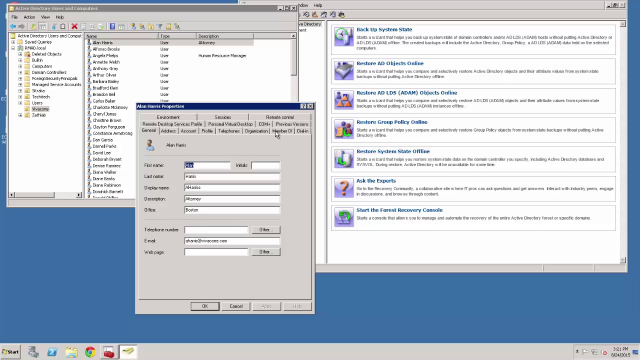Comparing Flexible AD Recovery Options
 07:36
07:36
Active Directory disasters require flexibility in recovery because no two environments or attacks are alike. Learn about the Recovery Manger restore options.
Related videos

Protect AD Backups from Malware Infection
Learn how to protect Active Directory backups from malware infection with Recovery Manager for Active Directory, Disaster Recovery Edition.
Duration: 09:10

Recover Active Directory 5x Faster with Quest Recovery Manager
To combat increasingly clever hackers and their ransomware, your organization needs to be able to backup/rapidly recover its Active Directory infrastructure.
With more than 69% of organizations having fallen victim to ransomware (according to CyberEdge Group), cyberattack recovery is crucial. Learn how Quest Recovery Manager for Active Directory Disaster Recovery Edition can aid your recovery efforts with:
- Reliable and efficient backups
- Secure storage
- Malware scanning
- Automated forest recovery
Duration: 02:43

How to respond to an Active Directory disaster with Recovery Manager
Learn what happens when Active Directory disasters strike when you’re protected by Recovery Manager for Active Directory, Disaster Recovery Edition.
Duration: 04:54

How do you protect against ransomware? We’ll show you.
How does ransomware get into your organization and how do you mitigate the damage? These ransomware experts discuss how.
Duration: 05:22

How to set up integration between Recovery Manager for AD and On Demand Recovery
Learn how to set up integration between Recovery Manager for AD and On Demand Recovery
Duration: 01:52

How to configure and manage backups in Recovery Manager
How to configure and manage backups in Recovery Manager for Active Directory, Forest Edition, and Disaster Recovery Edition.
Duration: 13:23

How to create a forest recovery project in Recovery Manager for Active Directory
Learn how to create a forest recovery project in Recovery Manager for Active Directory.
Duration: 09:47

How to use and navigate the Recovery Manager for Active Directory portal
Learn how to use and navigate the Recovery Manager for Active Directory portal.
Duration: 06:14

Highlight Reel! Quest at Microsoft Ignite 2018
Relive the fun. Revisit the people. Watch this quick recap of the fun and excitement at Microsoft Ignite brought to you by Quest.
Duration: 01:35

Reduce your recovery time from a Forest-level Active Directory disaster by 95%
Active Directory is at the heart of businesses around the world. Microsoft estimates that there are more than 473 million Active Directory accounts that authenticate close to 10 billion times during an average day.
That's why Active Directory problems, whether accidental or malicious, can cripple a business and cause It professionals many sleepless nights. We understand how important Active Directory is, and we help manage and protect more than 180 million AD accounts worldwide.
One small spark can take out your entire Active Directory forest. Assess your AD environment health, stopping problems before they burn everything down.
With Recovery Manager for Active Directory, you can reduce the time it takes to recover from the forest level AD disaster by 95%. Learn more about Active Directory Forest Disaster Recovery.
Duration: 01:06

Sauvegardez et sécurisez votre Azure AD avec Recovery Manager for Azure
On Demand Recovery for Azure AD offre une restauration rapide, sécurisée et évolutive des utilisateurs, des attributs, des groupes et des appartenances aux groupes, à partir d'une seule interface au format SaaS
Duration: 05:04

Overview of Recovery Manager for Active Directory
This video provides an overview of Recovery Manager for Active Directory.
Duration: 04:55

Active Directory Recovery Made Easy
Learn how you can protect your Active Directory data from disaster, reduce downtime, and perform granular restores with Recovery Manager for Active Directory.
Duration: 02:33



